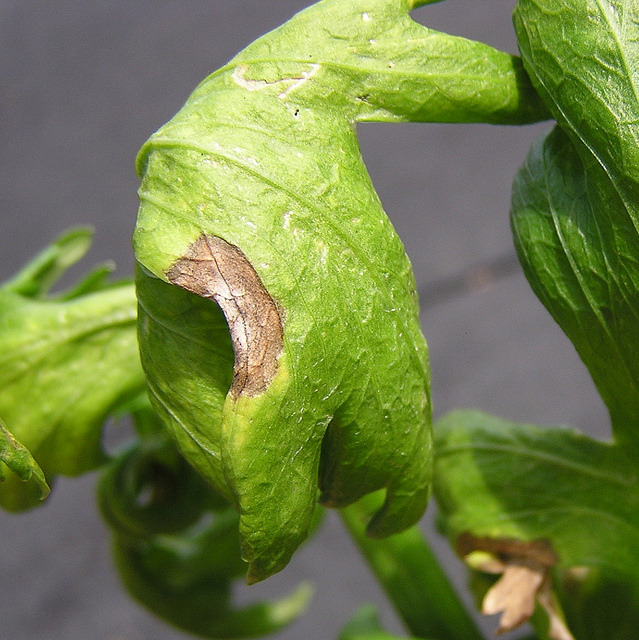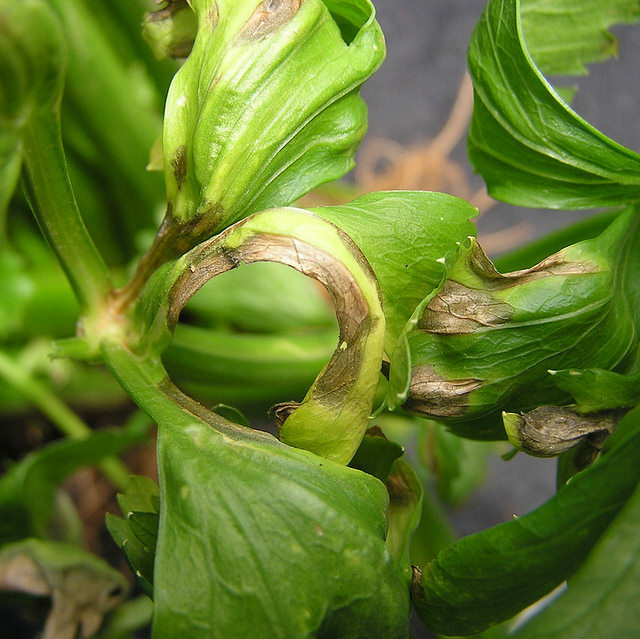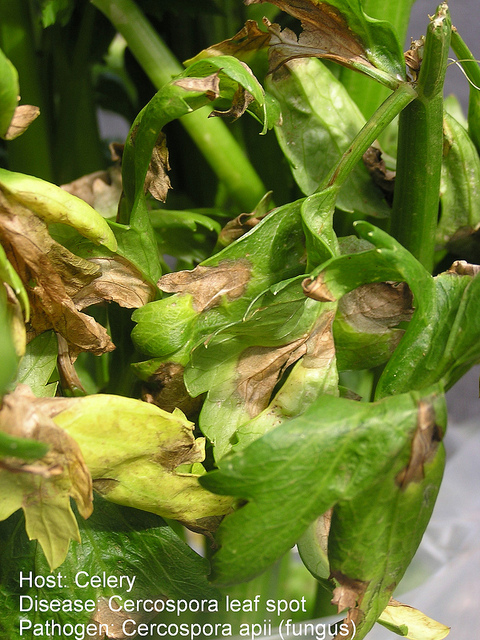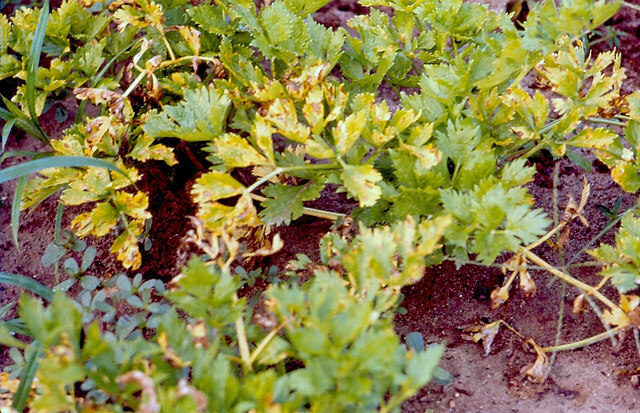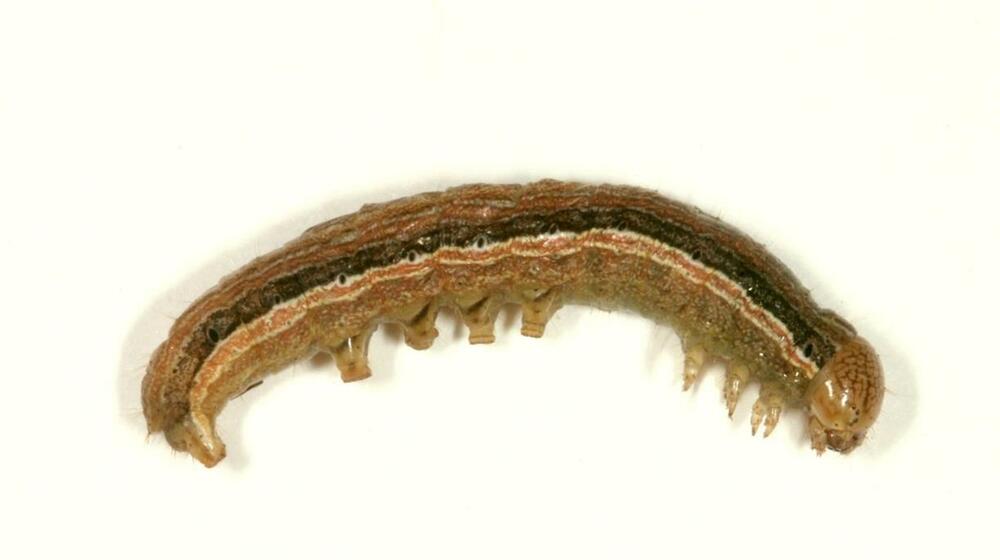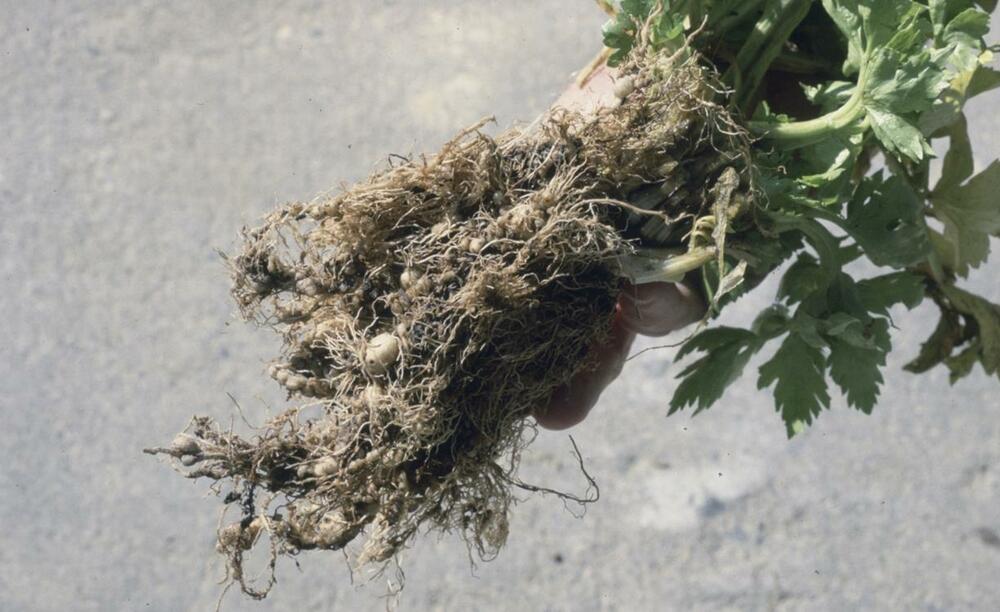Celery
Description
Uses
Propagation
References
Common Pests and Diseases
Diseases
Category : Bacterial
Bacterial blight and brown stem Pseudomonas cichorii
Symptoms
Small water-soaked spots on leaf blades which become necrotic and either circular or angular in shape and may develop a chlorotic halo; lesions become dry and rust colored; brown stem symptoms include the development of a brown discoloration of petioles and brown streaks along petioles
Cause
Bacterium
Comments
Close plant spacing favors bacterial spread between plants; bacterium causes severe disease symptoms at temperatures above 30°C (86°F)
Management
Control of disease is difficult and usually involve the application of copper sprays in commercial plantations; some control can be achieved by planting less susceptible celery varieties; mechanical transmission can be reduced by only trimming leaves when foliage is dry
Soft rot
Erwinia carotovora
Erwinia chrysanthemi
Pseudomonas marginalis
Symptoms
Small water-soaked lesions near base of petioles which become soft, sunken and brown
Cause
Bacteria
Comments
Bacteria thrive in oxygen depleted plant tissue; disease emergence requires long periods of water saturated soil; bacteria enter plants through wounds
Management
Control relies on the avoidance of conditions conducive to bacterial infection: plant celery in well-draining soils; allow plants to dry before irrigating again; avoid wounding plants during harvest to prevent pst harvest development of disease; disinfect all equipment regularlyCategory : Viral
Celery mosaic Celery mosaic virus (CeMv)
Symptoms
Veinclearing and mottling in areas of leaves between veins; leaves may be twisted, curled or cupped; dark green mottling on petioles; young plants may be stunted
Cause
Virus
Comments
Virus is transmitted by several species of aphid; aphids can successfully transmit virus to plants within 30 seconds of feeding and virus symptoms typically develop within 10 days of primary infection
Management
Control relies on the implementation of a 'celery-free' period of 1-3 months and controlling umbelliferous weeds that can act as a source of inoculumCategory : Fungal, Oomycete
Damping-off
Pythium spp.
Rhizoctonia solani
Symptoms
Soft, rotting seeds which fail to germinate; rapid death of seedling prior to emergence from soil; collpase of seedlings after they have emerged from the soil caused by water-soaked reddish lesions girdling the stem at the soil line
Cause
Fungi
Comments
Damping-off diseases favor conditions which slow seed germination; fungi can be spread in water, contaminated soil or on equipment
Management
Avoid planting celery in poorly draining, cool, wet soil; planting in raised beds will help with soil drainage; plant high quality seed that germinates quickly; treat seeds with fungicide prior to planting to eliminate fungal pathogensCategory : Fungal
Downy mildew Peronospora umbellifarum
Symptoms
Yellow spots on upper surface of leaves; white fluffy growth on underside of leaves; lesions become darker as the mature
Cause
Fungus
Comments
Disease affects young, tender leaves; disease emergence and spread is favored by prolonged leaf wetness
Management
Plant pathogen-free seed; do not overcrowd plants; rotate crops with non-umbelliferous varietiesEarly blight (Cercospora leaf spot, Cercospora blight) Cercospora apii
Symptoms
Small yellow flecks on upper and lower leaf surfaces which enlarge to brown-gray spots with no defined border; lesions develop a papery texture; leaves with many lesions may turn necrotic and die
Cause
Fungus
Comments
Fields become infected through infested seed; disease emergence is favored by warm temperatures and prolonged leaf wetness; disease can be differentiated from late blight by the absence of black fungal fruiting bodies embedded in leaves and the typically larger lesions
Management
In areas where warm temperatures and high humidity favor the emergence of early blight, control must rely on a number of different methods: plant pathogen-free seed; rotate crops; avoid overcrowding plants; plant tolerant or resistant celery varieties when conditions are favorable to early blight emergence; apply appropriate fungicides where availableFusarium yellows Fusarium oxysporum
Symptoms
Yellowing plants that are severely stunted; roots brown and water-soaked; discoloration of vascular tissue in the stems
Cause
Fungus
Comments
Fungus can persist indefinitely in soil once introduced and is usually introduced via infected transplants or contaminated equipment; disease emergence is favored by a soil pH which is close to 7
Management
The most effective method of controlling Fusarium yellows is to prevent its introduction by regularly sanitizing tools and equipment, planting in pathogen-free soil and planting resistant or tolerant varieties of celeryLate blight (Septoria leaf blight) Septoria apiicola
Symptoms
Irregularly shaped chlorotic spots on leaves and petioles which turn necrotic and coalesce to form large necrotic areas, blighting of leaves and leaf death; back fungal fruiting bodies are visible embedded in leaf tissue and resemble peppercorns
Cause
Fungus
Comments
Fungus can survive on seed for up to 2 years in storage; emergence of disease if favored by heavy rainfall and dense leaf canopies which prevent air circulation; fungus can be spread via rainfall or contaminated irrigation water and by the movement of people, tools or machinery
Management
Plant pathogen-free seed; treat seed with fungicide or hot water prior top planting; if disease is present, avoid working in area when plants are wet; apply appropriate foliar fungicides where available`Pink rot Sclerotinia scerlotiotum
Symptoms
Soft, brown lesions on base of stalks with pink margin which cause the entire stalk to rot, turn brown and collapse; large black fungal fruiting bodies are visible on infected tissue; when young seedling are infected, the fungus causing damping-off with a watery rot visibly on the seedling stems near the soil line
Cause
Fungus
Comments
Fungus can survive in soil for up to 10 years; disease emergence is favored by soils that are held close to saturation for periods in excess of 2 weeks
Management
Cultural practices play an important role in the control of pink rot: the use of drip irrigation 5-8 cm below the soil surface can provide good control; deep plowing of soil and trimming back foliage to promote air circulation can also be useful; fungicides may be warranted in periods of extended cool, damp weatherPowdery mildew Erisyphe heraclei
Symptoms
Powdery growth on leaves, petioles flowers stalks and bracts; leaves becoming chlorotic; severe infections can cause flowers to become distorted
Cause
Fungus
Comments
Fungus can spread long distances in air; disease emergence is favored by high humidity and moderate temperatures; infection is most severe in shaded areas
Management
Plant tolerant varieties; avoid excess fertilization; protective fungicide applications provide adequate protection; sulfur application can be used in infection occurs early in seasonPests
Category : Insects
Aphids (Carrot-williow aphids, Peach aphid, Hawthorn aohid, Melon aphid)
Cavariella aegopodii
Myzus persicae
Dysaphis apiifolia
Aphis gossypii
Symptoms
Small soft bodied insects on underside of leaves and/or stems of plant; usually green or yellow in color, but may be pink, brown, red or black depending on species and host plant; if aphid infestation is heavy it may cause leaves to yellow and/or distorted, necrotic spots on leaves and/or stunted shoots; aphids secrete a sticky, sugary substance called honeydew which encourages the growth of sooty mold on the plants.
Cause
Insects
Comments
Distinguishing features include the presence of cornicles (tubular structures) which project backwards from the body of the aphid; will generally not move very quickly when disturbed; aphids can build up to several thousand per celery plant.
Management
If aphid population is limited to just a few leaves or shoots then the infestation can be pruned out to provide control; check transplants for aphids before planting; use tolerant varieties if available; reflective mulches such as silver colored plastic can deter aphids from feeding on plants; sturdy plants can be sprayed with a strong jet of water to knock aphids from leaves; insecticides are generally only required to treat aphids if the infestation is very high - plants generally tolerate low and medium level infestation; insecticidal soaps or oils such as neem or canola oil are usually the best method of control; always check the labels of the products for specific usage guidelines prior to use.Armyworm Pseudaletia unipuncta
Symptoms
Singular, or closely grouped circular to irregularly shaped holes in foliage; heavy feeding by young larvae leads to skeletonized leaves; shallow, dry wounds on fruit; egg clusters of 50-150 eggs may be present on the leaves; egg clusters are covered in a whitish scale which gives the cluster a cottony or fuzzy appearance; young larvae are pale green to yellow in color while older larvae are generally darker green with a dark and light line running along the side of their body and a pink or yellow underside
Cause
Insect
Comments
Insect can go through 3–5 generations a year
Management
Organic methods of controlling armyworms include biological control by natural enemies which parasitize the larvae and the application of Bacillus thuringiensis; there are chemicals available for commercial control but many that are available for the home garden do not provide adequate control of the larvaeCategory : Nematodes
Root knot nematode Meloidogyne spp.
Symptoms
Galls on roots which can be up to 3.3 cm (1 in) in diameter but are usually smaller; reduction in plant vigor; yellowing plants which wilt in hot weather
Cause
Nematode
Comments
Galls can appear as quickly as a month prior to planting; nematodes prefer sandy soils and damage in areas of field or garden with this type of soil is most likely









